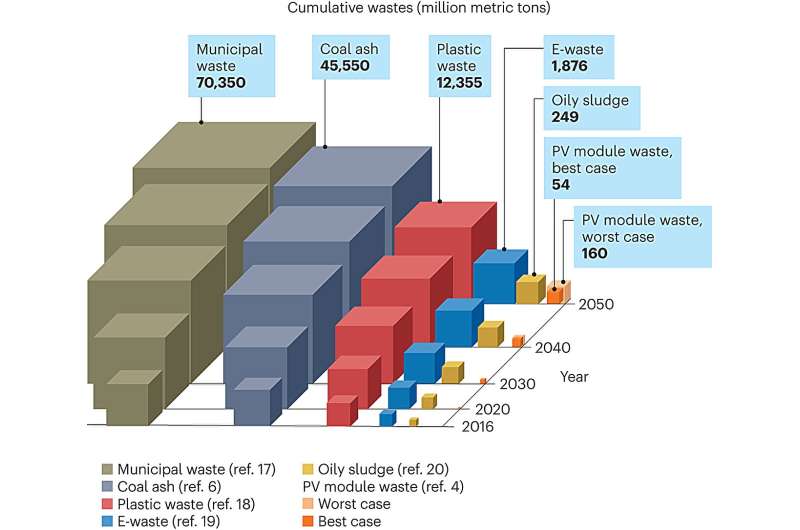October 16, 2023 report
This article has been reviewed according to Science X's editorial process and policies. Editors have highlighted the following attributes while ensuring the content's credibility:
fact-checked
peer-reviewed publication
trusted source
proofread
Research team counters solar energy misinformation

Resistance to adoption of solar panels as an economical and efficient replacement for fossil fuels is based on inaccurate information being spread by foes of renewable energy.
That's the finding of researchers at the National Renewable Energy Laboratory in Colorado who say claims about the toxicity of photovoltaic (PV) modules are spurring opposition to a promising energy alternative.
"Transitioning away from fossil fuels, a substantial reduction in waste mass and toxicity is possible and the remaining waste is well within our capabilities to manage responsibly," said study author Heather Mirletz. Her paper, "Unfounded concerns about photovoltaic module toxicity and waste are slowing decarbonization," appears in the journal Nature Physics.
"Communities, government agencies and policymakers may be operating under outdated or false assumptions about PV module waste and toxicity hazards resulting in delay or unnecessary impediments to the rapid deployment of PV needed to meet decarbonization goals," Mirletz said.
The report raises several points. Health sites in several states list PV toxins such as arsenic, gallium, germanium and hexavalent chromium. But the majority of PV units are composed of crystalline silicon or cadmium telluride, Mirletz said. Those are toxic substances, but comprise less than 0.1% of the modules, which consist mainly of glass, aluminum and polymers.
The report further cites the International Energy Agency (IEA) assertion that the "only potential human health and environmental concern" about PV models are "trace amounts of lead in solder" used in the manufacture of modules.
The IEA also states that the more recently used cadmium telluride is "extremely stable" and does not pose the same toxicological risk as cadmium.
Opponents of solar energy often cite the 2016 IRENA end-of-life report that calculated that if solar energy is embraced globally, 60 million tons of waste will be generated through PV disposal by the year 2050.
Mirletz notes that her group's study determined the number may be closer to 54 million tons, though in a worst-case scenario, she said, the number could go as high as 160 million tons.
But the lifetime of PV modules has nearly tripled since that report, and required PV capacity has risen sharply. Waste generated by fossil fuels—coal ash and oily sludge—are up to 800 times and five times greater, respectively.
"Compared another way," Mirletz said, "globally we will generate up to 440–1,300 times more mass of municipal waste than PV module waste by 2050."
NPR reported earlier this year that one leading source of misinformation was a former White House aide who once defended Donald Trump's claim that noise from wind turbines can cause cancer. Anti-solar energy activist Susan Ralston, NPR said, received hundreds of thousands of dollars from a key GOP donor and investor in fossil fuel companies.
"Incorrect information about toxic materials in PV modules is leading to unsubstantiated claims about the harms that PV modules pose to human health and the environment, fueling public concern and opposition to PV development," Mirletz said.
The report by Mirletz's team did not address at least two points previously raised by those opposing solar energy.
The Harvard Business Review in June 2018 took issue with the IRENA report. It said the report presumed the highly unlikely scenario that solar customers would keep their modules for the entire projected 30-year lifespan.
Accounting for the greater likelihood of turnover, the Harvard report estimated waste tonnage nearly 20% higher than the IRENA report. PV waste numbers cited by Mirletz's team would be significantly higher if they similarly ignored turnover probabilities.
Also, a 2017 toxic landfill waste report by the National Center for Biotechnology Information found, contrary to the Colorado report, that "given the high toxicity of cadmium," leakage of cadmium telluride, even in "marginal" amounts, underscores the need to limit its disposal in landfills.
More information: Heather Mirletz et al, Unfounded concerns about photovoltaic module toxicity and waste are slowing decarbonization, Nature Physics (2023). DOI: 10.1038/s41567-023-02230-0
© 2023 Science X Network


















